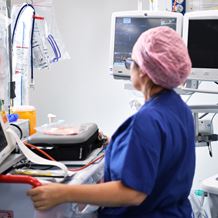
- Home
- Services
- Cardiac Services
- Procedures and Treatments
- Optical Coherence Tomography (OCT)
What is optical coherence tomography?
Optical coherence tomography is a type of high-resolution imaging procedure that is increasingly being used as a technique in cardiology to produce detailed images of your blood vessels. Usually performed alongside a coronary angiogram, an OCT uses a special near infra-red light to diagnose and guide treatment for various heart conditions. These include coronary artery disease, a heart condition caused by a build-up of plaque in the coronary arteries (atherosclerosis). The information collected can be used to assess the best placement for heart stents, monitor existing heart conditions and assess any abnormalities.
What does it do?
OCT is an advanced imaging technique that provides high quality images of the coronary arteries in real time. It can tell your doctor important information such as the exact level of calcification in your arteries, the best location for stent placement and whether there are any abnormalities in the blood vessels. An optical coherence tomography helps your doctor make an accurate diagnosis and implement informed treatment decisions about a variety of heart conditions including coronary artery disease and heart stent placement. The accuracy of OCT also enables your doctor to monitor existing treatment programs.
How does it work?
Optical coherence tomography works by inserting a special type of OCT catheter that emits a near infra-red light once it reaches the coronary arteries. An imaging probe collects the data produced from the light reflecting back, and converts this into high resolution images taken from inside the coronary arteries. These images are then displayed in real time which enables your doctor to assess the extent of any plaque build-up, evaluate the health of the artery walls, observe any abnormalities and make an informed treatment decision.
Why is it performed?
Optical coherence tomography is performed to provide detailed images of the inside of your coronary arteries. These pictures are crucial to diagnosing and treating a range of cardiovascular conditions that includes coronary artery disease. OCT can accurately measure the thickness of plaque build-up inside the arteries, and assess the risk of potential rupture. It is also performed to plan certain heart treatments such as heart stents and plaque removal (atherectomy). OCT can be used alongside other catheter-based heart procedures such as coronary angioplasty.
Procedure
OCT imaging can be performed non-surgically using local anaesthetic.
- A special catheter containing the OCT imaging probe and light is inserted into a blood vessel and guided towards the coronary arteries
- The catheter emits the light, and the imaging probe collects the data
- This continues while the catheter is withdrawn from the artery
- The data is processed in real time, creating high quality, detailed images of the coronary artery
- Your doctor is able to evaluate the results and assess for treatment if required
Recovery
After the procedure, your progress is monitored for a period of time in hospital. Some patients will be allowed to return home the same day. Your doctor will talk to you about your individual recovery and what to expect. There is likely to be some bruising from the insertion site, and this may remain tender for a couple of weeks. The recovery period will depend on your health and wellbeing going into the procedure and will typically vary by patient.
What's next?
If you have been experiencing heart-related symptoms, book an appointment with our cardiac services specialist today.
Our specialists in Cardiac Services
View all specialists





